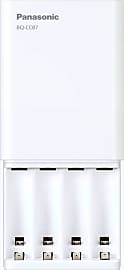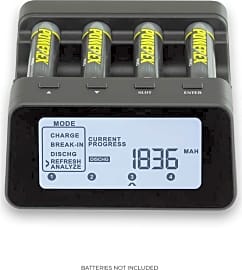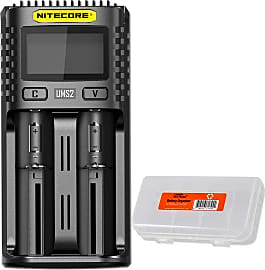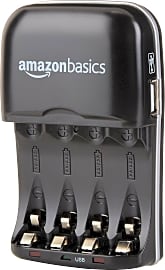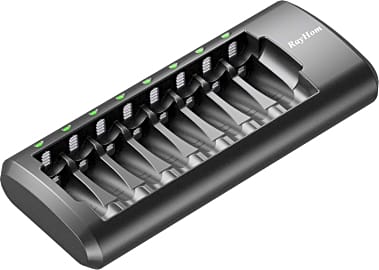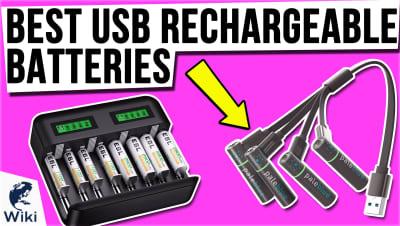The 10 Best AA & AAA Battery Chargers

This wiki has been updated 34 times since it was first published in September of 2016. Now that just about every device in the world is small and portable, you are going to need one of these AA and AAA battery chargers if you don't want to run out of juice at an inopportune moment. You'll never again lose the use of your TV remote, wireless computer mouse, or other small electronic gadget for more than a few seconds by always having a set of recharged cells on hand. When users buy our independently chosen editorial choices, we may earn commissions to help fund the Wiki.
Editor's Notes
October 29, 2020:
Due to their chemistry, rechargeable batteries have certain weaknesses when it comes to their ability to hold a charge, especially when they are not used regularly or are repeatedly fully discharged. Choosing a suitable charger will depend on the number of batteries you use and how often you need to recharge them. For occasional use, a simple model that, at a minimum, keeps the power levels topped up and checks for defects should be sufficient, however, if you rely on fully functioning cells to carry out your job, then a professional-quality charger will analyze, discharge, refresh or even restore them.
We have updated this ranking to reflect the most recent upgrades in battery technology, with choices available to suit most household and professional needs. The RayHom RM-33 is no longer in production and has been replaced with the RayHom 8-bay, which has similar functions, but uses LEDs rather than an LCD to indicate the battery's status. Nitecore has recently released the Nitecore UMS2 Intelligent, an improved version of their popular charger that can now accept a wider range, including nickel and manganese cells. The Titanium Innovations Genius MD-1600L was our original choice for charging in bulk, however, we decided to switch it for the Powerowl High Speed, as this model has better ventilation and cooling, and is almost half the price.
Energizer has launched the Energizer Universal range of chargers that are simple to use and a good choice for families with children, as there are no settings to adjust and the auto shut-off prevents damage by overcharging. On a more professional level, the popular Powerex MH-C9000 WizardOne has been updated with a backlit screen and a useful memory function in the Powerex MH-C9000 Pro. This option not only charges in one hour, but can also restore dead cells by repeatedly discharging and recharging them. The Panasonic BQ-CC55 has proved itself to be a reliable charger over the years, therefore we chose to replace it with the Panasonic BQ-CC87, which is essentially the same model, but with the ability to charge mobile devices using the stored batteries via its 5-volt USB output.
November 29, 2019:
There are two main concerns when it comes to charging batteries. The first is safety, so it's important to choose a charger with capable protection circuits to avoid disaster. In fact, we had to remove an earlier Powerex model after finding evidence that it may not have shut off automatically in the event of a failed cell. We've replaced it with the technologically advanced Powerex MH-C9000 WizardOne, which lets you intricately fine-tune the rate at which your batteries are charged and discharged. Both it and the La Crosse BC-1000 Alpha Power are intended for users who want the utmost control over the process. The La Crosse offers 4 selectable speeds, so it's not quite as tunable as the Powerex, but it's almost there.
If you're not concerned with custom charging speeds, the Panasonic BQ-CC55 is an excellent choice that performs quickly and reliably in real-world testing. The Energizer Recharge, meanwhile, affords you the ability to refuel various types of cells including Cs and Ds and its dust cover means you can use it in some environments where there's a risk of a little bit of foreign material in the air. The Bonai ZN825E and RayHom RM-33 both accommodate up to 8 batteries; the first uses USB power and the second a standard AC outlet. The EBL 6201 is another USB-powered model, this time one with 4 bays, and because it's so light and inexpensive it's a reasonable choice for travelers. Similarly lightweight and affordable is the Nitecore New i2 Intellicharge, which also accommodates large and powerful 18650 lithium-ion batteries. The AmazonBasics V-3299 is interesting because not only does it do away with the need for a power cord, it also features an integrated USB port for charging electronics that don't have removable batteries.
We also want to take a second to mention that, no matter how frugal and convenient of an idea it sounds, don't ever try to recharge disposable batteries, alkaline or otherwise. While it might work decently a couple times, the risk of failure, explosion, and acid sprays is simply too great. With that out of the way, check out our rundown of good AA batteries as well as this interesting roundup of cells with built-in USB chargers.
How Battery Chargers Work
This only works with certain pairs of metals, including nickel and cadmium, which are common in AA and AAA household rechargeables.
To understand the technology at work in a battery charger, one must first be familiar with how batteries themselves function. Essentially, batteries consist of two different metals separated by a somewhat porous insulating material. The metals must have chemical potentials that are not equal to one another. Chemical potential is the energy that is inherently stored within the molecules and atoms that make up the metal itself.
Because of the imbalance of chemical potentials in the two metals, when connected to a circuit, a battery works to automatically balance itself. In that process, a stream of electrons flows from the metal serving as the anode, which is negatively charged, through the circuit, and back to the metal serving as the cathode, which is positively charged. This allows the anode to give up its negative charge and the cathode to absorb the electrons that it emits, once they've passed through the circuit. Somewhere along the way, the electrons can be used to power a cell phone, car, or just about anything else.
In standard batteries, often called primary, the flow of electrons cannot be replenished. When either the anode or cathode is spent, the battery can no longer power anything. The most common type of primary battery uses zinc as its anode and a carbon rod as its cathode.
Rechargeable batteries work because their flow of electrons can be reversed. This only works with certain pairs of metals, including nickel and cadmium, which are common in AA and AAA household rechargeables.
Battery chargers work by reversing the flow of electrons. In this process, the metal that works as the anode while being discharged technically becomes the cathode, and vice versa. For that reason, those terms aren't generally used for rechargeable batteries. The charger applies a direct current to enable this process, usually drawn from a wall outlet or USB port where household batteries are concerned.
This process also applies to other types of rechargeable batteries, like those found in cars. In order for a battery to successfully recharge, the current applied must be slightly greater than its output. More powerful currents can recharge batteries faster, but also lead to a greater risks of overheating, damage, or explosion.
Why Use Rechargeable Batteries
The benefits of using rechargeable batteries are myriad. For one thing, though the cost of the batteries themselves may be somewhat greater than their disposable counterparts, they will save you money in the long run. Of course, overhead costs may outweigh long-term benefits for some customers. That being said, over the course of several years, the savings become considerable. The more batteries you use, the faster you'll recoup your investment.
Aside from the personal cost and time savings you'll experience with rechargeable batteries, you'll also be doing your part to help the planet.
Once you've invested in a good set of rechargeable batteries and one of the chargers on our list, the benefits continue. Perhaps the most noticeable impact is that it will be a long time before you have to go out and buy new batteries again, if you ever do. If disposable AA or AAA batteries are often on your shopping list, you'll be sure to notice the convenience when they're no longer necessary. Instead of remembering to buy new ones, you just need to remember to charge them. This shouldn't be too hard, as you're probably used to taking the batteries out of a device when they're dead and tossing them in the trash. If you're worried you'll forget, just put your charger next to your trash can as a reminder.
Aside from the personal cost and time savings you'll experience with rechargeable batteries, you'll also be doing your part to help the planet. In addition to taking up space in landfills, discarded batteries also leak harmful substances like mercury and lead into the earth. Recycling batteries can mitigate this issue, but that option is not available everywhere. Even where it is, many households can't be bothered with the added hassle of bringing their used batteries to a designated drop-off site. While some states do mandate residents to do so, it's a difficult policy to enforce.
Most rechargeable batteries can be charged up to 1,000 times. That means, in the long run, you're saving yourself the cost of 999 disposable batteries. If you typically throw used batteries in the trash, you're also keeping those 999 extra batteries out of a landfill. It's okay to pat yourself on the back.
Rechargeable Battery Technology
If you've ever shopped for rechargeable household batteries before, you may have noticed that there are quite a few types on the market. In truth, there are far more kinds of rechargeable batteries than those found on shelves at supermarkets and electronics stores. Lead-acid batteries power most cars, while lithium-polymer is the technology found in many cell phones.
While it's typically thought of in terms of shelf-life for disposable batteries, it can be represented as a percentage per month for rechargeables.
The most common types of rechargeable AA and AAA batteries include nickel cadmium, nickel metal hydride, and lithium-ion. Rechargeable alkaline manganese batteries are also available, and are often cheaper than other options, but tend to have limited life cycles. Lithium-ion batteries, by comparison, typically last the longest of any type.
Self-discharge is the phenomenon of a battery losing its charge when not in use, and is present among all battery types, including disposables. While the rates tend to be higher among rechargeable units, there are many factors involved in the rate at which a battery loses its charge. These include age, storage temperature, and the charge capacity at which a battery is stored. While it's typically thought of in terms of shelf-life for disposable batteries, it can be represented as a percentage per month for rechargeables.
Lithium-ion batteries typically have the lowest self-discharge rate of all rechargeable battery types. They tend to lose two to three percent of their charge each month while in storage, compared to four to six percent for lead-acid and 15 to 20 percent for nickel-cadmium. Standard nickel metal hydride, or NiMH batteries, have the highest self-discharge rate at up to 30 percent per month. To combat that effect, Sanyo introduced a so-called "low self-discharge NiMH" style under their Eneloop brand in 2005. These have self-discharge rates closer to those of lithium-ion models.


